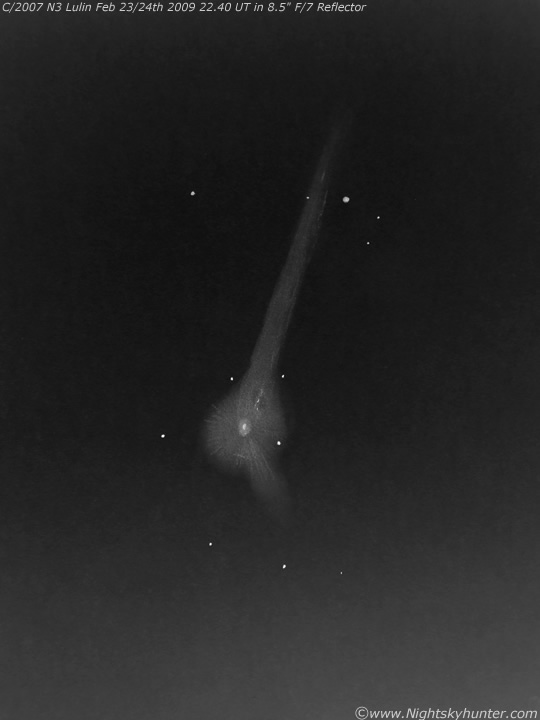BACK
C/2007 N3 LULIN - THE SWORD COMET
 |
BACK |
C/2007 N3 LULIN - THE SWORD COMET |
||
|
On February 23/24th I was very fortunate to have made my 10th observation of C/2007 N3 Lulin. The reason I was lucky was because the forecast was for overcast conditions over N. Ireland, and indeed it looked hopeless during the even with a solid blanket of stratus blocking the stars. During the late evening I took a cat nap then suddenly awoke with the comet in mind. I looked out the window and was shocked to see a clear sky. In the E was planet Saturn in Leo well placed above the local rooftops. I ran outside with the 10x50mm binos for a quick look incase it clouded over. This was the main night observers had been waiting for because Lulin was at its closest to Earth (38 million miles) and only 2 degrees below Saturn. The binos showed both very clearly in the same field with an anti-tail pointing away from the planet. The sky was getting better by the minute and soon it was 100% crystal clear with a black sky filled with brilliant stars. I set up my camera and took approx 30 images at different focal lengths and when content that I had a digital record of the event I then set-up the 8.5" F/7 reflector in the back garden in preparation for a serious look at this wonderful comet.
When full dark adaption set in I could see Lulin easily below Saturn as a large 5th mag elliptical haze much like a fainter version of Messier 44. Then with amazement, using averted vision, but just once, I could glimpse the anti-tail without optical aid as a slim line pointing away from the golden planet above. This was the first time I have ever seen this kind of tail with the naked eye. This set the mood for an unforgettable observing session. Over the next 1.5 hours I observed the comet in extreme detail making this the best view I've had to date. I was struck by just how much the comet had changed since I last observed it. It was obvious that this close Earth approach combined with a forward scattering/opposition effect had enhanced the magnitude of the main dust features. The coma was a huge green elliptical haze over 25' in dia and moderately condensed with a vivid white coloured central condensation. Lurking in the centre of this was a lovely bright star-like false nucleus which seemed to be exploding with activity. I was under the impression that the real nucleus, unseen and cocooned within those white mists, was a large object indeed. Faint field stars lurked within the green coma and a grouping of brighter stars could be seen near the coma's edge. This chance arrangement came in useful for gauging the comet's rapid motion. Within a few min's it was obvious that the comet was moving to the W and N as the comet-star angle gradually changed. This was very striking even in this low power 32mm 2" super wide angle eyepiece. It was amazing to think that this comet was moving more than sixty times faster than a bullet as it raced past planet Earth. One thought came to mind - thank goodness it didn't have our name on it - Lights out!.
The anti-tail was absolutely incredible. When I first seen it in the scope against such a dark sky back ground I felt an instant release of adrenaline due to the excitement of it's appearance. The tail blazed across the FOV for at least 1 degree to the SE. It was broad at the base where it emerged the coma then tapered to a point way beyond a bright field star which tried to compete for attention but failed miserably. The tail looked for all the world like a monstrous green blade or sword!. The eerie light along it's entire length was very intense, uniform, and complete with perfection sporting a sharp edge on either side. A film of material from the coma curved gracefully down from the elliptical head and blended in with the anti-tail's base. I watched with awe as this green phantom passed over back ground stars which further accentuated the comet's speed and size. That tail must have been huge!. Glancing further N to the opposite side of the coma I could just make out a strange looking ion tail pointing away from the Sun. Unlike the solar-pointing spike to the S, this tail was colourless, faint, and elusive so required good dark adaption and movement of the scope to bring out the details. This tail was not like it's brilliant brother, but instead seemed to 'jut' out from the coma at an awkward 45 degree angle to the NE. A closer look revealed a multitude of fine streamers forming a wedge-shaped enhancement. Taking in both these tails and the coma at the same time was a sight I will never forget. Guiding the scope two degrees above the comet I could see Saturn with it's near edge-on ring system and several of it's Moons which only added to the experience, an experience that gave me a euphoria like a kid playing with their old toys or children in a candy shop. What a memorable session I had!.